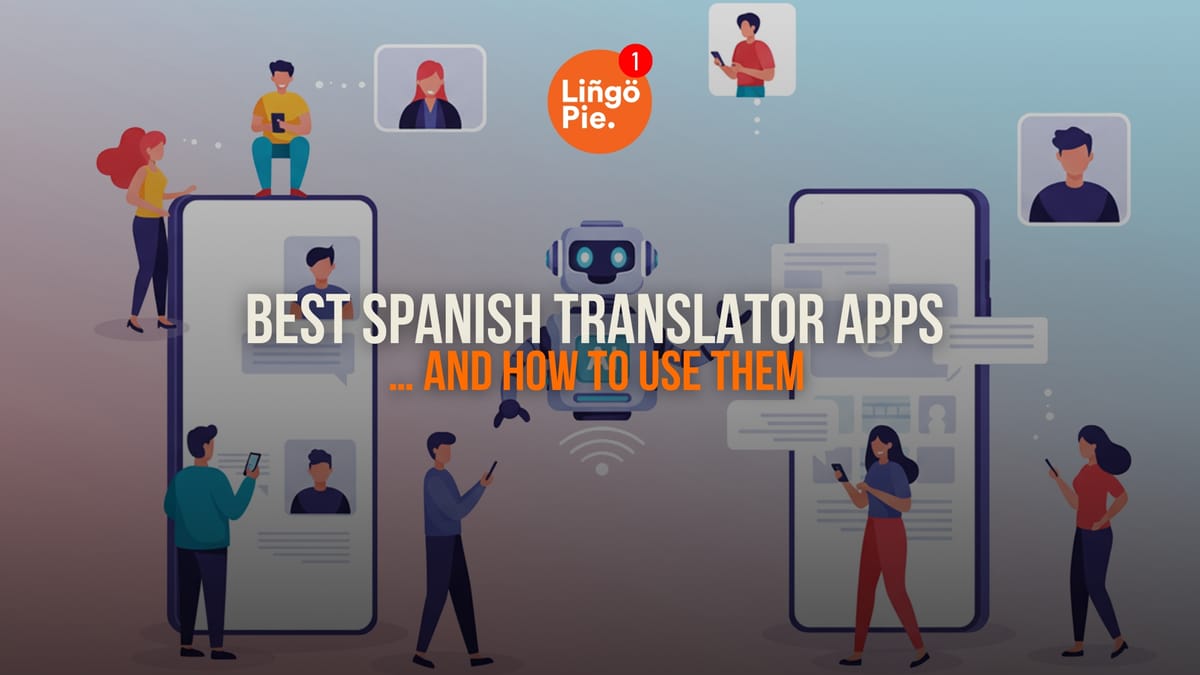Books, podcasts, TV shows, and Spanish classes are all great, but when you’re out in the real world, you’ll often need a little extra help. Fortunately, there are now several Spanish translator apps available today! These apps can be installed on your phone or tablet so you can easily translate words, phrases, or even full conversations on the go.
In this post, you’ll discover the 8 best Spanish translator apps to help you communicate more confidently. We’ll explore what makes each one stand out, how to use them effectively, and which apps fit different learning styles. Let's begin!
- 31 Colombian Slang & Bad Words EXPLAINED
- 19 Nicaraguan Slang That’ll Surprise You [Guide]
- 80 Spanish Love Words Every Romantic Should Know

Why Use Spanish Translation Apps?
Spanish translation apps are powerful learning tools that help you bridge gaps in understanding, boost confidence, and build real-world fluency. They give you instant access to native phrasing, pronunciation, and context that textbooks can’t always provide. Here’s why they’re worth having on your phone:
- Instant feedback: Quickly check if you’re using the right word or phrase without waiting for a teacher or class.
- Real-world context: See how words are used in everyday situations, not just textbook examples.
- Pronunciation help: Many apps include audio features, so you can hear and repeat correct pronunciation.
- Offline access: Some apps work without internet — perfect for traveling or studying on the go.
- Visual and voice translation: Translate signs, menus, or spoken Spanish instantly using your camera or microphone.
A quick note: Don’t rely too heavily on translator apps. They’re great for quick help, but translating everything word-for-word can hold back your progress — and sometimes the literal translations miss the real meaning. Use them as a guide, not a crutch.

Spanish Translation Apps Worth Using
Google Translate

Google Translate is the world’s most popular translation app. It supports over 100 languages (including Spanish) and lets you translate text, speech, handwriting, and even images with your camera. For Spanish learners, it’s especially useful because you can check words or phrases instantly, listen to how they’re pronounced, and even translate live conversations in real time.
It’s free, works offline with downloaded language packs, and integrates smoothly with your phone’s keyboard or browser. While it’s not perfect for nuanced or idiomatic Spanish, it’s still the best first app to install if you’re starting out.
| Pros | Cons |
|---|---|
| Free and supports 100+ languages | Literal translations can miss cultural context |
| Text, voice, and image translation | Struggles with complex or idiomatic phrases |
| Offline mode available | May not teach grammar or natural phrasing |
| Easy to use and widely accessible | Interface can feel too automatic for serious learners |
Reverso

Reverso is a context-based learning tool that helps you understand how Spanish is used in real life. It provides translations with real examples from movies, news articles, and everyday conversations, making it easier to see how words fit naturally in sentences. The app also includes pronunciation audio, grammar explanations, and flashcards for memorizing phrases.
It’s great for intermediate and advanced learners who want to move beyond direct translation and start thinking in Spanish. While some example sentences can be off, it’s still one of the best apps for learning through real-world context.
| Pros | Cons |
|---|---|
| Translations come with real example sentences | Some examples can be mismatched or awkward |
| Includes pronunciation and grammar tools | Requires internet for most features |
| Built-in flashcards help reinforce learning | Interface can feel cluttered for beginners |
| Great for understanding natural language use | Not ideal for full text or document translation |
SpanishDict
SpanishDict is one of the most trusted tools for English–Spanish learners. It’s especially good for beginners who want clear translations, example sentences, and accurate verb conjugations. You can look up any Spanish word and instantly see how it’s used, how to pronounce it, and how it changes across tenses.
The app also includes quizzes, video lessons, and flashcards that make it easy to build your vocabulary over time. If you’re learning Spanish seriously (not just translating), SpanishDict is a must-have companion.
| Pros | Cons |
|---|---|
| Designed specifically for Spanish learners | Less useful for other languages |
| Includes conjugations, pronunciation, and examples | Limited offline features |
| Built-in quizzes and flashcards for practice | Interface can feel busy with ads on free version |
| Extremely accurate for vocabulary and grammar | Doesn’t handle full-sentence or long-text translation well |
Lingopie

Lingopie isn’t a translation app in the traditional sense but it helps you absorb Spanish naturally through TV shows, movies, and real conversations. Instead of translating isolated words, Lingopie lets you learn in context by watching authentic Spanish content with interactive dual subtitles. You can click on any word or phrase to see its meaning, hear pronunciation, and instantly add it to your flashcards for review.
This makes it an amazing companion to translation apps: while other tools help you understand Spanish, Lingopie helps you use and remember it. If your goal is fluency (not just translation!) Lingopie bridges the gap between study and real-life Spanish.
| Pros | Cons |
|---|---|
| Learn Spanish through real shows and movies | Requires a subscription after the trial |
| Interactive subtitles make vocabulary stick | Not designed for instant text translation |
| Built-in flashcards and listening practice | Works best with a stable internet connection |
| Immersive, real-world learning experience | Limited offline access compared to translator apps |
DeepL
DeepL has earned a reputation as one of the most accurate translation tools available today. Known for its natural, human-sounding translations, DeepL is ideal for learners who want to understand not just what a sentence means, but how it would actually be said by a native speaker. It’s especially strong when translating full paragraphs or documents, often capturing nuance that other apps miss.
While it doesn’t have as many languages or built-in learning tools as some competitors, its clean design and quality output make it a top choice for serious learners and professionals alike.
| Pros | Cons |
|---|---|
| Translations sound more natural and accurate | Fewer language options than Google Translate |
| Excellent for long texts and nuanced writing | Some advanced features require a paid plan |
| Simple, distraction-free interface | Limited features for beginners or casual learners |
| Can translate documents and preserve formatting | Less suited for quick on-the-go translations |
iTranslate

iTranslate is a sleek, traveler-friendly translation app designed for quick, on-the-go communication. It supports over 100 languages, including Spanish, and can translate text, voice, or even conversations in real time. One standout feature is its ability to switch between dialects — for example, European vs. Latin American Spanish — which helps learners hear regional differences.
The app also includes a built-in phrasebook and offline mode (for paid users), making it a convenient option when you’re abroad or practicing your speaking skills.
| Pros | Cons |
|---|---|
| Translates text, voice, and conversations in real time | Most advanced features require a paid plan |
| Supports 100+ languages with dialect options | Some translations sound unnatural or robotic |
| Includes phrasebook and offline mode (Pro version) | Free version limits usage and offline access |
| Simple, travel-friendly interface | Not ideal for deep grammar or contextual learning |
Linguee
Linguee is a hybrid between a dictionary and a translation search engine — and it’s fantastic for learners who care about context. Instead of giving you a single translation, Linguee shows you real examples of how words and phrases are used in authentic Spanish texts (like news articles or professional documents).
This makes it easy to spot subtle differences in meaning and choose the right translation for your sentence. It’s also available offline, making it reliable for studying or traveling without data. While it doesn’t offer live translation or voice features, its depth of examples makes it one of the best tools for improving written Spanish and understanding nuance.
| Pros | Cons |
|---|---|
| Real examples from authentic Spanish sources | No voice or image translation options |
| Excellent for understanding context and nuance | Not ideal for quick, conversational translation |
| Works offline once downloaded | Interface feels more like a dictionary than an app |
| Very accurate and detailed translations | Doesn’t support full text or speech translation |
WordReference

WordReference is a classic tool trusted by language learners and translators for years. It’s a deep resource for understanding the why behind Spanish words and expressions. You’ll find definitions, verb conjugations, synonyms, and even discussion forums where native speakers explain tricky grammar points or idioms.
It’s not flashy or full of AI-powered features, but it’s one of the most reliable sources for serious learners who want precision and context. It also won’t translate whole paragraphs or conversations, but it’s an unbeatable reference for expanding your vocabulary and grasping subtle differences in meaning.
| Pros | Cons |
|---|---|
| Extremely detailed dictionary and conjugation tools | Doesn’t support full-sentence or voice translation |
| Native-speaker forums explain tricky phrases | Interface looks dated and text-heavy |
| Great for grammar, idioms, and regional differences | Requires manual searching — not instant translation |
| Free and ad-light | Not ideal for casual or travel use |
SayHi Translate
SayHi Translate is one of the simplest and most user-friendly translation apps out there. It’s designed primarily for live conversations — you speak in English or Spanish, and the app instantly translates and speaks it back in the other language.
The interface is clean and fast, making it perfect for travelers or learners who want to practice speaking with instant feedback. You can adjust the speech speed, switch between male and female voices, and even save useful phrases. However, it’s not a deep learning tool since accuracy can vary depending on accent and internet connection.
| Pros | Cons |
|---|---|
| Instant voice-to-voice translation | Requires internet for most features |
| Very easy to use with a clean interface | Can struggle with accents or fast speech |
| Adjustable speech speed and voice options | Lacks offline mode and learning tools |
| Great for travel and basic conversations | Limited accuracy with slang or idioms |
Which Spanish Translator App Is Best for You?
The best Spanish translator app really depends on how you learn and what you need most. However, translation apps are only part of the journey. They help you understand words, but Lingopie helps you live them.
By watching real Spanish shows with interactive subtitles, you will hear how native speakers talk, learn phrases in context, and remember them naturally. Use translator apps for quick support, but turn to Lingopie to build true fluency through authentic, everyday Spanish.
Start watching and learning with Lingopie today, and make Spanish a part of your daily life.





![11/11 Singles’ Day in China: What Is It And How Is It Celebrated [Guide]](/blog/content/images/size/w1200/2025/11/Singles-day-in-china.jpg)



![How to Learn Spanish as An Adult [Guide]](/blog/content/images/size/w300/2025/12/How-to-Learn-Spanish-as-An-Adult.jpg)